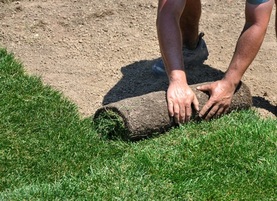 Laying sod in your yard is instantly gratifying. You can turn barren areas into an area with a perfect grass in a day. First things first, you will need to have the ground prepared to help the sod take root quickly. The soil needs to be loosened to a depth range between four and six inches. If you need to bring in additional soil to fill in low spots, we recommend either top soil with a sandy loam or river-silt. Fertilize the soil with a slow release, complete fertilizer. Follow the directions on the bag but do not water it in. This is not recommended from September 1st through April 15th. It is important to remember sod comes in its own environment. It is very important to avoid leaving the sod moisture deprived for very long. Apply a lot of water to the sod within thirty minutes of laying the first piece. Leave your sprinkler in one place for two hours and then move it until the entire newly laid sod has been equally soaked. Initially you will need to keep the sod wet for the first five to fourteen days depending on temperature. Do not let the sod dry out until the union between the sod and soil surface is firmly established. This means the roots have grown into the soil and the grass cannot easily be lifted. During the cool months, these instructions are not as crucial as sod will not require as much water. For the first week water thoroughly every day. For the second week, water every other day. If it rains, it should be at least one inch before skipping a watering. After two weeks, water as needed. When the grass looks healthy and rooted, you may let it dry out some to promote root development. The best time to water is in the morning, so less water is lost by evaporation. The worst time to water is in the evening, because the lawn stays wet all night and this encourages disease development. Also, lawns watered too frequently tend to develop shallow root systems, which may make the sod more susceptible to grub damage. When the grass is 50% higher than you desired mowing height, it should be mowed. Mow often enough that you do not remove more than 1/3 of the blade at one time. Clippings are beneficial in that they return nutrients and organic matter to the soil. If grass is mowed on a timely schedule, clippings do not contribute to thatch.
5 Comments
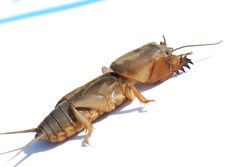 Mole crickets are a true pest for homeowners in the south. They are omnivores, eating grubs, earthworms, bermudagrass and centipede grass. They will not bite your if you hold them in your hand, but they will try to dig through you as if your hand were soil. In large enough numbers, they can devastate your lawn. Mole crickets are nocturnal and live mostly underground, so it is unlikely that many of you have seen a mole cricket. It is highly probably that you have seen the signs of them and not known what caused it. Signs of mole crickets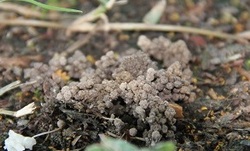 Mole crickets usually leave small mounds in the soil. They look like minature versions of a crawfish mound or like small mud volcanoes for those of you unfamiliar with mud bugs. There can also be trails of disturbed soil consisting of small pellets. This is from them moving around under the soil. If you see these, your can confirm your suspicions with a soapy water test. Mix 1-1/2 tablespoons of dish soap with 2 gallons of water and pour it over about four square feet of grass. Wait a few minutes and whatever bug is down there will rise to the surface so they don't drown. If it looks like the picture at the top of the page, you've identified the pest. How to exterminate mole cricketsWhile the ugly bug shown at the top of the page is the most noticeable, it is their young that cause the most damage to your grass. Luckily, they are also the easiest to exterminate. Adult mole crickets can and will burrow deep into the ground at the first sign of danger from pesticides and wait it out for months. The young mole cricket nymphs aren't able to do the same. Usually early spring is when you will want to treat for these if you've ever had a problem before. This will be the most effective time. If you live in southern Louisiana, you are looking at a march application.
Mole crickets usually mate in fall and can be seen flying (yes they can fly) to find a mate. Mole crickets also hibernate deep in the soil in winter. Since they are away from the damaged area, treating for mole crickets at either of these times is ineffective. Pest control products containing imidacloprid or fipronil are good for preventing a population from growing. They also provide long lasting control which will help since mole crickets can evade danger for extended periods. If you have a large active mole cricket problem, you should use pest control products containing bifenthrin. As with all pesticides, follow the product label first and foremost.  Dad, he's done quite a lot for you throughout your life. For father's day, try to go beyond the expected gift of neckties, socks, or paper weights and get dad something he really wants. 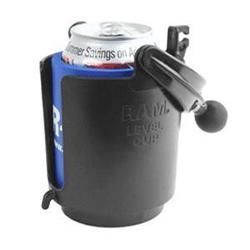 RAM Mount Drink Cup Holder It is a self leveling drink cup holder that can attach to ATVs, Motorcycles and even his lawn mower. Great, inexpensive gift to keep dad cool when he's outside. 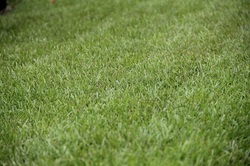 Professional Lawn Mowing Giving someone lawn care is really giving them more time to do what they want to do. Most people would love to get this as a gift.  Sport Tickets Is your pop a Baseball, football, or basketball fan? Secure a set of tickets to ensure he is over the top thrilled with your gift this year. 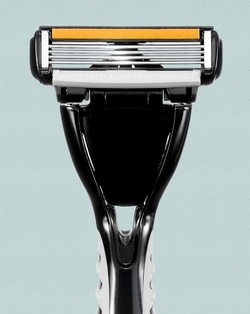 Razors for the Year This may sound expensive and not shining example of what dad would want, but fresh razors all year is an awesome gift. There are also cheap and easy ways to do this, for example Dollar Shave Club is cheap and ships them right to your dad's door every month.  Golf Gift Card Even if your dad has never golfed or if he is a pro, he will enjoy a gift card to go golfing at a nice course in town. It lets him go and spend a day either by himself or with friends and enjoy the outdoors.  Steak If all else fails, go with steak. Unless your dad doesn't eat red meat, a nice cut of steak or a gift certificate to a good steak house will always be enjoyed. If you asked your dad if he would rather a tie or a 12 ounce bone in ribeye, I think the answer is very apparent.
alatesAlates, commonly referred to as swarmers, are the termite colony's way of branching out and starting new colonies every year. Luckily, only a small minority of the swarmers actually start a new colony, Unluckily, those colonies grow over years to become enormous with the termite populations numbering in the millions. The number of termites per colony is one key contributor to why the Formosan termite species causes more damage so quickly when compared to our native termites. what to do if you have swarmers in your home?First and foremost, If you have termites swarming your home, call GreenSeasons or your termite company of choice to inspect your home. While having a large swarm of termites in your home is unpleasant, it does not necessarily mean you have termites actively damaging your wood. These termites can travel from their originally colony which could be in a tree or some firewood. If this is a recurring event every year for you and others in your neighborhood, you or someone near you probably has an infestation.
If you find pairs of wings and no termites, that means some termites may have paired up and will be starting a colony close by. It will take two pairing termites up to ten years to build up enough workers to cause real damage. Unlike our domestic termite which colonized underground, Formosan termites can start a colony in the wood in your home if they have 2 things: wood and water. Termites need wood and water to live. While your stuck with wood, you can stop the water. Make sure to thoroughly inspect your home, especially in that area for water leaks, drips or condensation buildup. We recommend having a licensed professional inspect your home at least annually for termites. |
AuthorCharlie Casselberry Categories
All
Archives
April 2024
|
Contact |
Services |
About |
Locations
|
GreenSeasons
|
Baton Rouge Office
11628 S Choctaw Drive, Suite 227 Baton Rouge, Louisiana 70815 |
Greenwell Springs Office
14461 Frenchtown Road Greenwell Springs, LA 70739 |
Slidell Office
56010 Highway 433 Slidell, Louisiana 70461 |
© 2020 GreenSeasons


 RSS Feed
RSS Feed
